Saturday, March 13, 2004
Taxes in the Roman Empire
A page about Roman taxes, from the Republic through Constantine, at UNRV. Diocletian's ill-considered price controls are mentioned.
Æ antoninianus, Rome, Gallienus, Göbl 731b
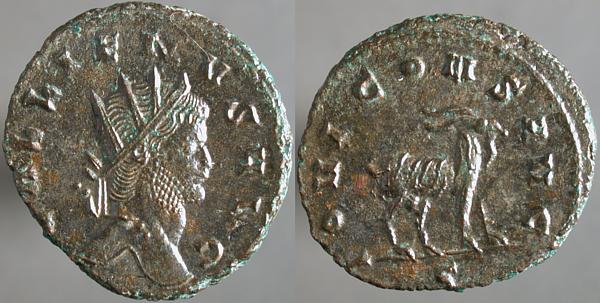
GALLIENVS AVG, Radiate head right | IOVI CONS AVG, Goat standing right. Digamma in exergue.
On Monday we saw a coin of Valerian II featuring the infant Jove riding a goat. Here, a coin of his father naming Jove as the protector of the Emperor, depicting a goat. I particularly favor the stripes on this goat.
Towards the end of his reign, Gallienus issued a series of coins featuring animals, real and mythological, as symbols of gods protecting the emperor. An extensive treatement of this "zoo" can be found here.
Friday, March 12, 2004
Æ27, Anemourion in Cilicia, Valerian, Ziegler 213

ΑVΤ Κ Π ΛΙ ΟVΑΛΕΡΙΑΝΟΝ, Laureate cuirassed bust right, seen from slightly behind | ΕΤ Β ΑΝ_ΕΜΟVΡΙΕωΝ, Cultus statue of Diana Ephesia.
Ziegler, Muenzen Kilikiens aus kleineren deutschen Sammlungen, 213. Thanks to Curtis Clay for the attribution.
Some history of Anemourion.
Artemis was the Greek predecessor of Diana, a harsh ethereal virgin goddess of the moon, the woods, and the hunt, sister of Apollo. How she became associated with this many-breasted nourishing fecund earth-mother is unclear to me.
Thursday, March 11, 2004
Silvered Æ antoninianus, Antioch, Gallienus, Göbl 1610i
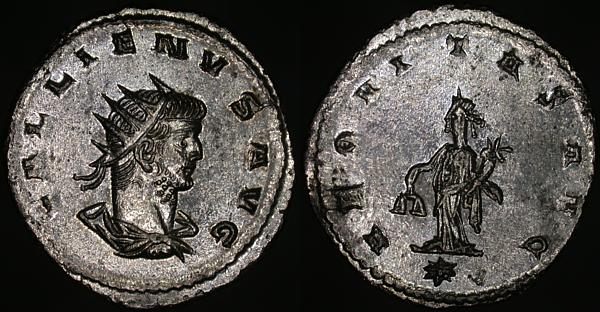
GALLIENVS AVG, Radiate draped cuirassed bust right | AEQVITAS AVG, Aequitas standing facing, head left, holding cornucopia right and scales left. Star in exergue.
Equitable treatment by the emperor was a common theme on Imperial coins, doubtless more common than in real life. The scales, attribute of Aequitas, have been acquired by our allegory of Justice.
Wednesday, March 10, 2004
Roman Coins
Æ16, Carthaginians in Sicily?, c. 4th-3rd century BCE?, cf. Sear 6444
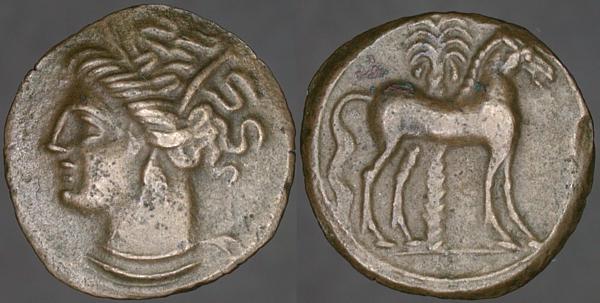
Head of Tanit left, wearing necklaces and grain wreath | Horse standing right, palm tree behind.
Tanit was the Phoenician fertility goddess, and, along with the horse alone or with palm tree, was commonly featured on their coins. I know very little about Phoenician coinage, but this small bronze came along at the right time and price and serves as a nice foil to Roman coins. A chronologic review of Carthage and its coinage here.
If any reader does have a good reference for this coin, mail would be appreciated.
Here, a Point-Counterpoint sort of thing on Phoenician child sacrifice.
(Tanit, you ignorant slut.)
Tuesday, March 09, 2004
Æ23, Anazarbus in Cilicia, Valerian, SNG Cop 61var
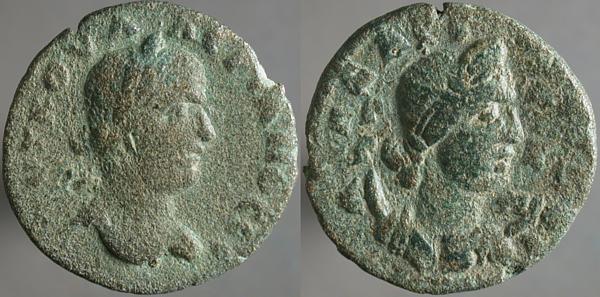
ΑVΤ Κ ΟVΑΛΕΡΙΑΝΟC CΕ, Laureate head right | ΑΝΑZΑΡ[...], Bust of Artemis (or Selene?) right, crescent behind shoulders. Γ/Γ in left field, Α/Μ/Κ in right field.
More about Anazarbus.
I don't have a reference that's specific to Anazarbus, and the more general catalogs that I do have don't list this reverse for a simple laureate head, but only for more decorated busts like this.
Monday, March 08, 2004
"up to one million coins per day"
Billon antoninianus, Rome, Valerian II, Göbl 247k
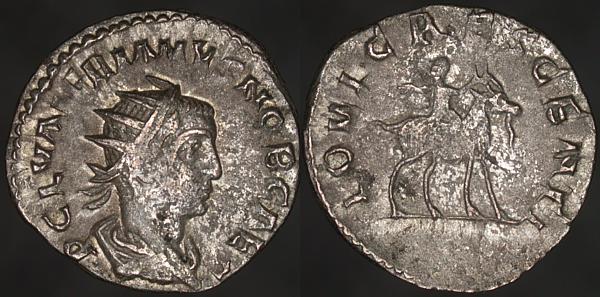
P C L VALERIANVS NOB CAES, Radiate draped cuirassed bust right | IOVI CRESCENTI, Infant Jove riding Amalthean goat right, raising hand left.
Coins using this reverse design were also issued for Valerian II, older son of Gallienus and Salonina, and for no one else in this dynasty, at Viminacium and Köln. Clearly this was in some way significant, perhaps indicating that he was born under the sign of Capricorn.
Sunday, March 07, 2004
Æ28, Anazarbus in Cilicia, Valerian, SNG Cop 56, Lindgren I, 1446
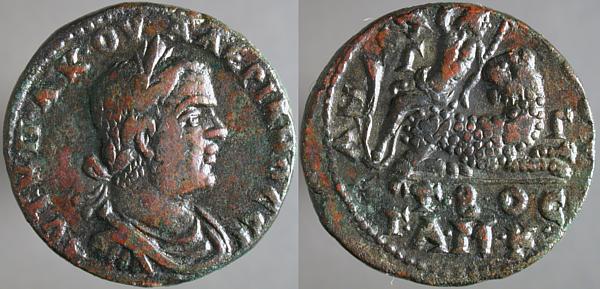
ΑVΤ Κ Π·ΛΙΚ·ΟVΑΛΕΡΙΑΝΟC CΕ, Laureate draped cuirassed bust right | ΑΝ_ΑZ_[...], Dionysus, holding thyrsos right and right arm over head, head right, seated left on leopard lying right, head left. Γ in upper left field, Γ in right field, kantharos in lower left field. Τ·Β·ΟC / ·Α·Μ·Κ· in exergue.
Lots of interesting history at Anazarbus.
Dionysus was roughly equivalent to the Roman Bacchus, but neither the bacchanalia nor Festivals of Dionysus are ever what people have in mind when touting "old time religion."
At least it's not Phoenician child sacrifice. Phoenician coin coming on Wednesday.

